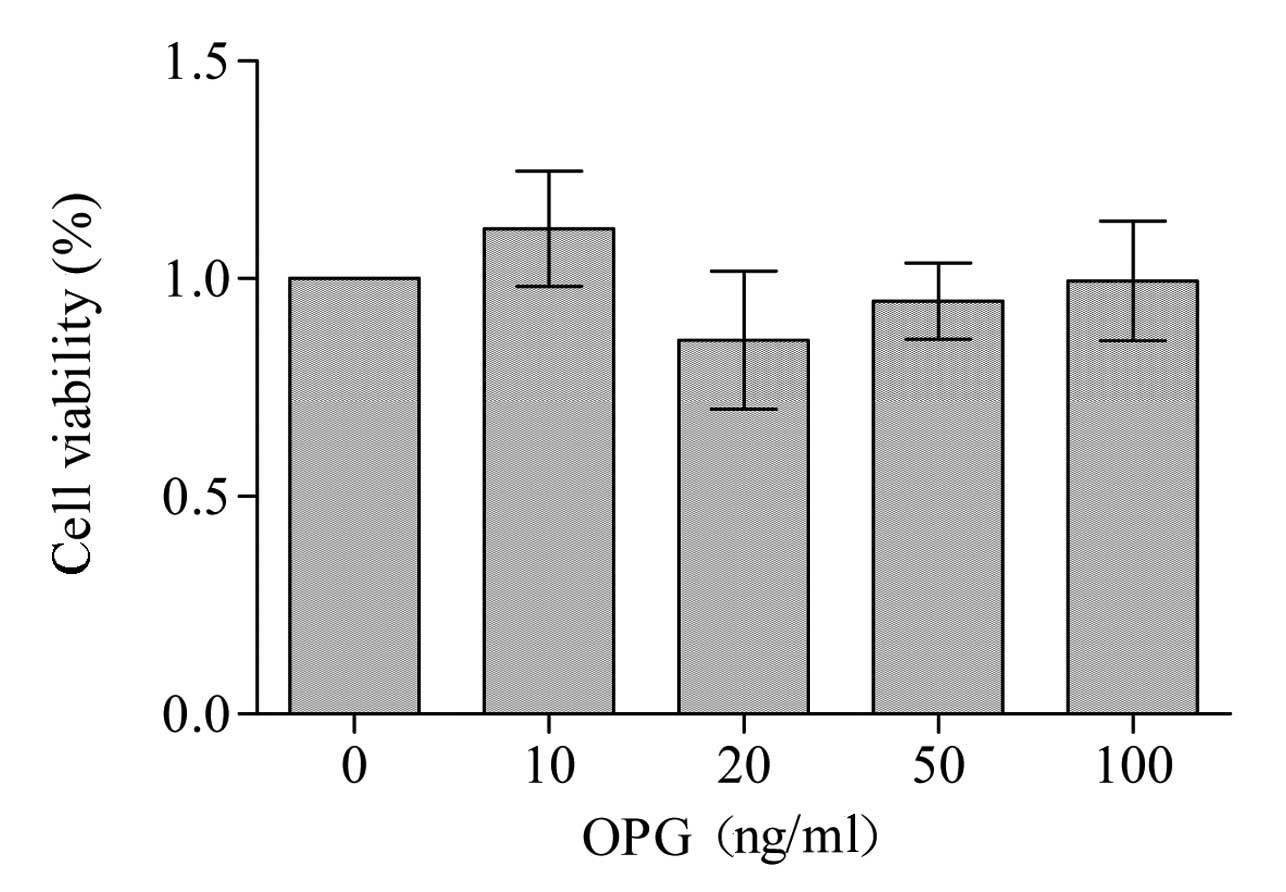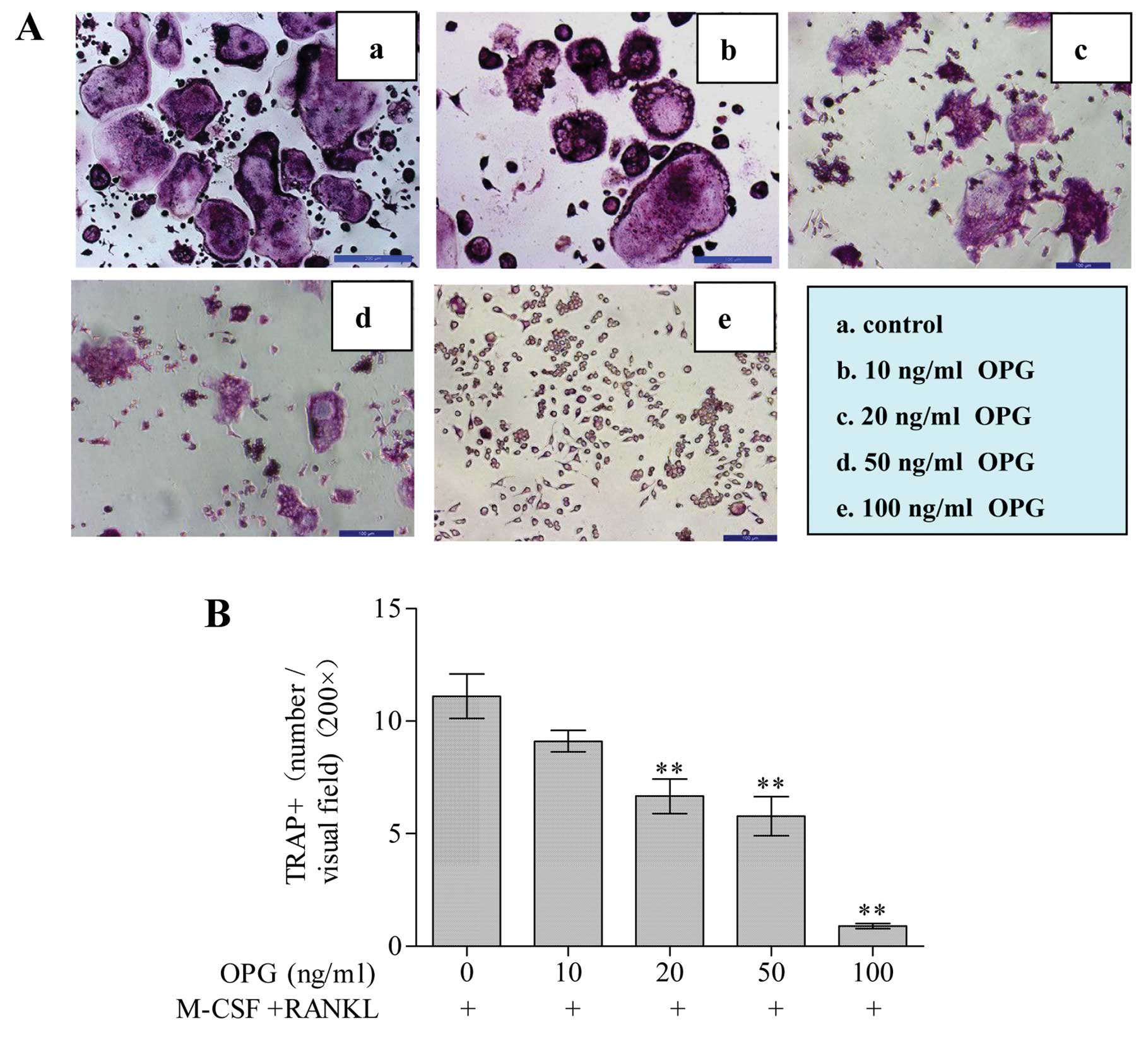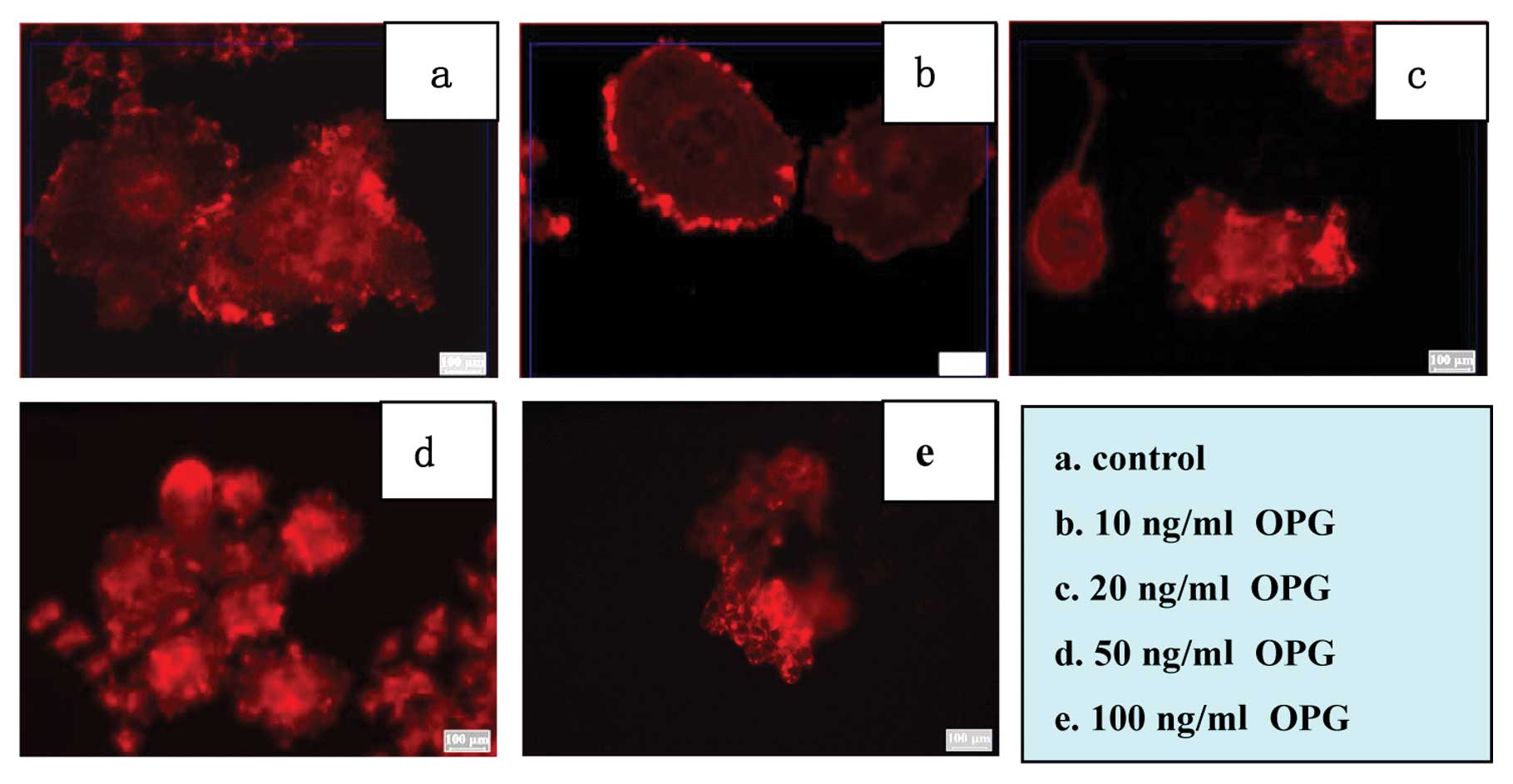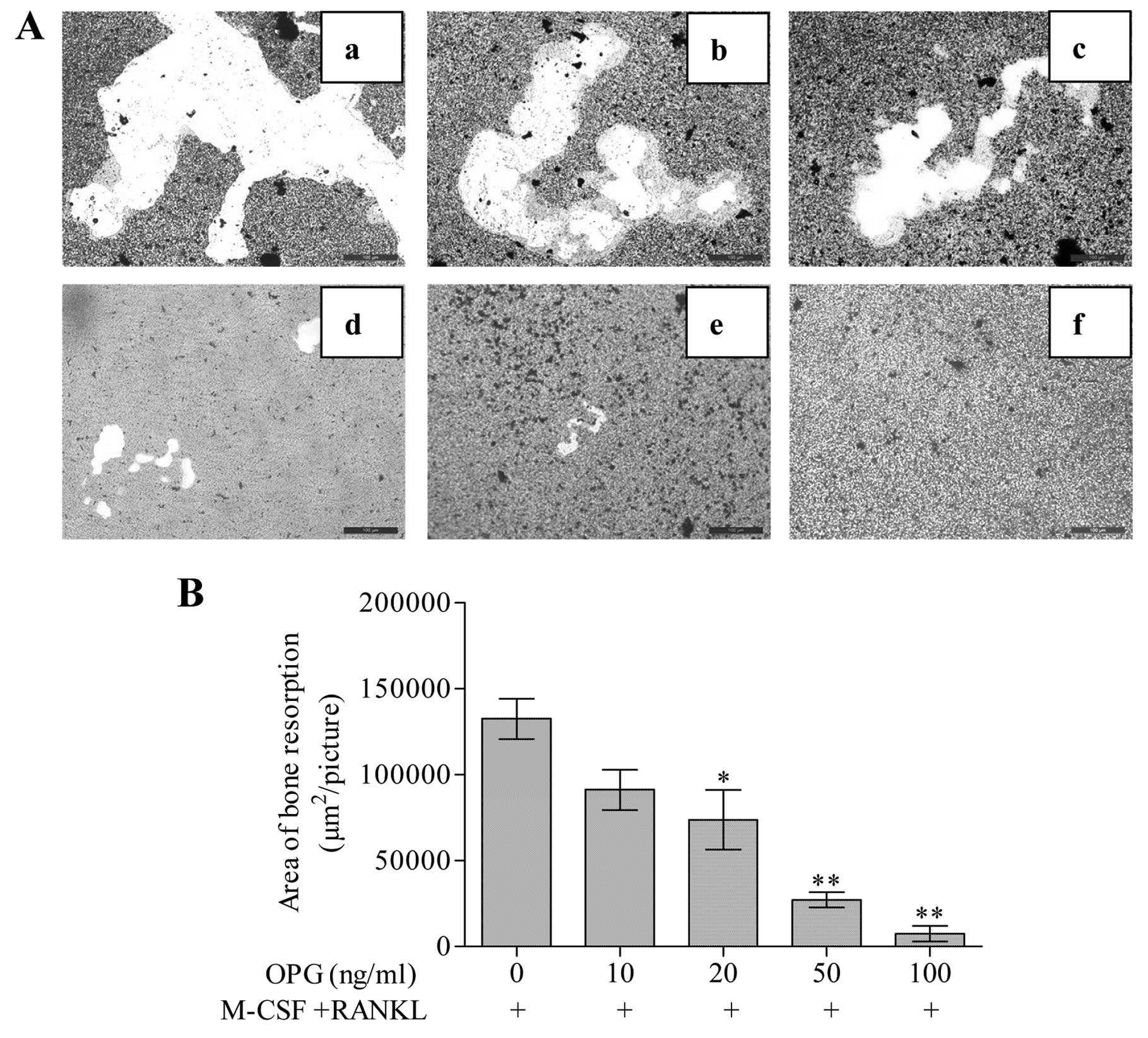Osteoprotegerin influences the bone resorption activity of osteoclasts
- Authors:
- Published online on: April 4, 2013 https://doi.org/10.3892/ijmm.2013.1329
- Pages: 1411-1417
Abstract
Introduction
In higher vertebrates and mammals, the bone is constantly being remodeled in order to regulate its architecture to satisfy mechanical needs and to repair damaged tissue; it is a highly dynamic tissue. Activation of osteoclasts initiates the remodeling cycle, which resorbs the underlying bone tissue, followed by the activation of osteoblasts, which are responsible for the formation of new bone tissue (1,2). The two processes must be tightly balanced to ensure proper bone homeostasis and calcium metabolism, and loss of this balance leads to several skeletal disorders (3,4). Osteoclasts are multinucleated cells of the monocytic-macrophage lineage, and are derived from hematopoietic stem cells through a series of differentiation steps (5). Osteoclasts require cytokines, especially macrophage colony-stimulating factor (M-CSF), for their survival (6,7). The receptor activator of nuclear factor-κB ligand (RANKL), expressed in osteoblasts and synovial fibroblasts as well as in T cells (5), represents the crucial regulator for osteoclast differentiation and activation (8). M-CSF and RANKL are essential for osteoclastogenesis in vitro (9). Simonet et al (10) previously demonstrated that osteoprotegerin (OPG) is involved in the regulation of bone density. OPG can prevent the binding of RANKL to its receptor, RANK, and blocks signaling cascade of osteoclast formation in vitro and in vivo (11,12). OPG knockout mice displayed osteoporosis owing to enhanced bone resorption at local sites. The decreased activity in osteoclasts induced by exogenous OPG may improve bone mass (13).
It is well known that cathepsin K, MMP-9 and carbonic anhydrase II (CA II) genes are involved in osteoclastic bone resorption (14). Wittrant et al (15) reported that OPG exerts an overall inhibitory effect on the expression of cathepsin K and MMP-9 in differentiated RAW264.7 cells in a dose-dependent manner. Chen et al (16) previously demonstrated that OPG inhibits the expression of CA II mRNA in mouse osteoclast-like cells. Therefore, how OPG alters the expression of cathepsin K, MMP-9 and CA II mRNA in different treatment periods to osteoclasts becomes a critical question that requires further elucidation. In this study, the effects of OPG on the bone resorption activity of osteoclasts were investigated via TRAP staining, F-actin staining, resorption activity analysis and osteoclastic bone resorption-related gene expression using RAW264.7 cells. The purpose of this study was to lay the foundations for the OPG treatment potential to abnormal osteoclast bone resorption activity.
Materials and methods
RAW264.7 cell culture
Murine monocyte/macrophage cell line RAW264.7 was obtained from the American Type Culture Collection (Manassas, VA, USA). It was cultured in DMEM (Gibco, USA) supplemented with 10% FBS, 100 U/ml penicillin, 100 μg/ml streptomycin and 2 mmol/l L-glutamine. The cells were suspended in α-MEM (containing 10% FBS) and placed in 96-well plates for TRAP-staining, and were seeded in Corning Osteo Assay Surface (COAS; Corning Inc., USA) for F-actin staining and resorption activity analysis, respectively. After 24 h of incubation, the medium was changed to serum-free α-MEM with 25 ng/ml M-CSF + 30 ng/ml RANKL (M-CSF and RANKL were obtained from Peprotech Inc., USA). For 48 h cultivation, 0, 10, 20, 50 and 100 ng/ml OPG (Peprotech Inc.) were added into various groups in the presence of the two cytokines, and the cells were cultured for another 24 h.
Cell viability MTT assay
To examine the effect of OPG on cell growth, RAW264.7 cells were treated with various concentrations of OPG and cell growth was measured by an MTT assay. In brief, the cells were plated in 96-well plates in α-MEM containing 10% FBS and incubated for 24 h. The medium was then changed to α-MEM without FBS and after 48 h different concentrations of OPG (0, 10, 20, 50 and 100 ng/ml) were added to the culture for another 24 h. At the end of the incubation, plates were washed with PBS three times, and DMEM (without FBS) containing 10% MTT solution (0.5 mg/ml in PBS) was added to each well. After a 4-h incubation period at 37°C, the insoluble formazan crystals formed were dissolved in 150 μl of dimethyl sulfoxide (DMSO). The optical density (OD) was immediately measured at 570 nm using Sunrise microplate reader (Tecan, Austria).
Osteoclast differentiation from RAW264.7 cells
Osteoclast formation was measured by quantifying cells positively stained by TRAP (Acid Phosphatase Kit 387-A; Sigma-Aldrich, USA). TRAP staining was conducted according to the manufacturer’s protocol. Under a light microscope, TRAP-positive multinucleated cells having three or more nuclei were considered as osteoclasts, and their numbers were counted in randomly selected visual fields in different areas of each well.
Filamentous (F) - actin staining
RAW264.7 cells were seeded in COAS. For visualization of the actin cytoskeleton, TRITC-conjugated phalloidin (Invitrogen) was employed, and was used at a concentration of 20 μmol/l. At the end of the incubation, cells were fixed, permeabilized and stained following the manufacturer’s instructions. The stained cells were observed by an inverted phase contrast fluorescence microscope (DMI 3000B; Leica) with appropriate filters.
Resorption activity analysis
The manipulation followed the COAS product protocol. In brief, at the end of cultivation, medium was aspirated completely and 10% bleach solution was added for 5 min of incubation. Bleach solution was removed and the wells were washed twice with dH2O. The plates were allowed to air dry completely for 3–5 h. Pits appeared as individual or multiple clusters at the bottom of the wells and were visualized via an inverted phase contrast microscope. The area of resorption lacunae was measured by image analysis (Version 1.0; JEDA).
Real-time fluorescence quantitative polymerase chain reaction (PCR) analysis
RAW264.7 cells were suspended in α-MEM (containing 10% FBS) and then seeded in 6-well culture plates. After 24 h of cultivation, the medium was changed to serum-free α-MEM with 25 ng/ml M-CSF + 30 ng/ml RANKL and was maintained for 48 h. For concentration gradient study, 0, 10, 20, 50 and 100 ng/ml OPG were added into various groups in the presence of the two cytokines. The OPG treatment was continued for 30 min, and cells were treated by M-CSF + RANKL for another 30 min as control groups. For the time gradient study, 100 ng/ ml OPG were added into various groups in the presence of the two cytokines. The OPG treatment was continued for 15, 30, 60 and 120 min, individually, and cells were treated with M-CSF + RANKL without OPG for another 15 min as control groups.
Total RNA was extracted at the indicated time-points. cDNA synthesis was conducted with 900 ng RNA using PrimeScript RT reagent Kit with gDNA Eraser (Takara, Japan). Real-time PCR was performed by the 7500 Real-Time PCR system (Applied Biosystems). The PCR protocol for cathepsin K, MMP-9 and CA II consisted of 40 cycles of 95°C for 30 sec and 57°C for 1 min. The specific sequences of the PCR primers for cathepsin K, MMP-9, CA II and GAPDH were: cathepsin K, forward, 5′-CGC-CTG-CGG-CAT-TAC-CAA-3′ and reverse, 5′-TAG-CAT-CGC-TGC-GTC-CCT-3′; MMP-9, forward, 5′-GCC-CTG-GAA-CTC-ACA-CGA-CA-3′ and reverse, 5′-TTG-GAA-ACT-CAC-ACG-CCA-GAA-G-3′; CA II, forward, 5′-CAT-TAC-TGT-CAG-CAG-CGA-GCA-3′ and reverse, 5′-GAC-GCC-AGT-TGT-CCA-CCA-TC-3′; GAPDH, forward, 5′-AAA-TGG-TGA-AGG-TCG-GTG-TG-3′ and reverse, 5′-TGA-AGG-GGT-CGT-TGA-TGG-3′. All real-time PCR reactions were carried out at least three times, and the specificity of the PCR products was verified by melting curve analysis.
Statistical analysis
All experimental data are expressed as the means ± standard error of the mean and all experiments were repeated in triplicate. Statistical differences between groups were evaluated by Tukey’s test using SPSS ver. 17.0 software. P<0.05 was considered to indicate statistically significant differences.
Results
Action of OPG on RAW264.7 cell viability
OPG did not affect the cell growth rate of RAW264.7 cells (Fig. 1), sustaining substantial viability even when used at concentrations of 100 ng/ml OPG (99.45%). This indicated that OPG was not cytotoxic to RAW264.7 cells. Therefore, the concentrations of 0, 10, 20, 50 and 100 ng/ml OPG were employed in the subsequent experiments.
OPG inhibits the formation of TRAP-positive multi-nucleated cells
RAW264.7 cells cultured in the presence of M-CSF + RANKL for 4 days formed large mature osteoclasts with multinuclei characterized by the acquisition of mature phenotypic markers, such as TRAP (Fig. 2A). At the same time, different concentrations of OPG were added to RAW264.7 cells when stimulated with M-CSF + RANKL. The number of TRAP-positive multinucleated cells decreased with increasing OPG concentrations (Fig. 2A). OPG reduced the number of TRAP-positive multinucleated cells generated for 17.28±9.12, 37.91±20.87, 48.12±9.81 and 89.71±3.15% inhibition at 10, 20, 50 and 100 ng/ml concentrations, individually (Fig. 2B). Collectively, these results indicated that OPG inhibited M-CSF + RANKL-induced osteoclastogenesis.
Effect of OPG on the F-actin rings forming in osteoclasts
M-CSF + RANKL-treated RAW264.7 cells formed large multinucleated osteoclasts with dense and smooth F-actin rings on the COAS. However, their development was inhibited by OPG. They were higher-ordered and evident around osteoclasts in the control groups and had lower concentrations in the OPG groups. Nevertheless, only F-actin clusters or belts were observed in 100 ng/ml OPG groups rather than F-actin rings (Fig. 3). These results indicated that the effect of OPG on bone resorption was due to its negative influence on the F-actin ring formation.
Effect of OPG on the resorption activity of osteoclasts
RAW264.7 cells were stimulated with M-CSF + RANKL to induce the differentiation of mature osteoclasts with bone-resorbing capacity. Cavities appeared in the bottom of COAS with various shapes. The bottom of COAS was not intact and smooth in any cell group (Fig. 4A). However, OPG hindered the resorptive capacity of osteoclasts and in a dose-dependent manner (Fig. 4B). The volume of resorption lacunae was significantly less in M-CSF + RANKL + 20, 50 and 100 ng/ml OPG groups than in the control groups (P<0.05). OPG inhibited the total area of resorption lacunae with 30.23±16.90, 44.35±21.07, 78.61±9.16 and 94.60±5.88% at 10, 20, 50 and 100 ng/ml concentrations, individually.
Regulation of cathepsin K, MMP-9, CA II mRNA expression in M-CSF + RANKL-induced osteoclast cells by OPG
The production of cathepsin K, MMP-9 and CA II gene expression for bone resorption by osteoclasts was monitored by real-time PCR. For concentration gradient study, expression of the three genes in cells cultured without M-CSF + RANKL were all significantly lower than in control groups (P<0.05). Expression of cathepsin K, MMP-9 mRNA in the OPG groups was statistically significantly lower than in control groups (P<0.01). OPG decreased the expression of cathepsin K mRNA 0.28±0. 06, 0.36±0. 06, 0.33±0.06, 0.44±0.11-fold, it decreased the expression of MMP-9 mRNA 0.57±0. 02, 0.60±0.05, 0.54±0.03, 0.44±0.08-fold at 10, 20, 50 and 100 ng/ml concentrations, respectively, and it decreased the expression of CA II mRNA 0.34±0.07, 0.35±0.16-fold at 10 and 20 ng/ml concentrations, respectively. However, the expression of CA II mRNA in the 50 and 100 ng/ml concentration groups was not significantly different to the control groups (Fig. 5A–C). For time gradient study, after OPG was added, expression of the MMP-9, cathepsin K and CA II genes in cells cultured without any exogenous cytokine for another 15 min were all significantly lower than in control groups (P<0.05). Furthermore, expression of the cathepsin K, MMP-9 and CA II genes in cells cultured with M-CSF + RANKL plus OPG for 15 min were not significantly different compared to their control groups, respectively. This demonstrated that OPG seldom affected the expression of MMP-9, cathepsin K and CA II mRNA in RAW264.7 cells in a short period. When treated with OPG for 30 min, all three significantly decreased (P<0.01), demonstrating that OPG inhibits the expression of the three genes the most at this time-point. Expression of MMP-9 and CA II genes was significantly lower than in the control groups from 30 to 120 min via OPG treatment (P<0.05). OPG decreased the expression of MMP-9 mRNA 0.82±0.03, 0.55±0.08, 0.18±0.09-fold and it decreased the expression of CA II mRNA 0.86±0.01, 0.78±0.02, 0.66±0.01-fold, at 30, 60 and 120 min, respectively (Fig. 5D–F). However, the expression of MMP-9 and CA II mRNA increased as the effect of OPG declined. This indicated that OPG still exerted inhibitory effects, albeit weaker, on two of them. The expression of cathepsin K mRNA was significantly increased with the OPG treatment for 60 to 120 min (P<0.01) (Fig. 5E).
Discussion
The hallmark of osteoclasts is their unique ability to resorb mineralized calcium apatite or carbonate substrates such as bone, dentin or nacre (17). In the osteoclast resorption process, F-actin ring formation is critical (18). F-actin is first organized into podosome (19), osteoclasts exhibit two different actin cytoskeleton organizations according to their substratum. They form canonical podosomes on non-mineralized substrates while they form sealing zones on mineralized extracellular matrices (17,20). Podosome clusters are built in early osteoclasts, which evolve into dynamic rings at intermediate stages and form peripheral podosome belts in mature cells by fusion of the rings (21). When the osteoclasts are polarized, they exhibit sealing zones and exert bone resorption activity (17,20). In sealing zones, the F-actin filament builds attachment ring structures, thus, in activated osteoclasts, compact ring structures were usually observed when F-actin was stained (22). The RAW264.7 cell line is a recognized pre-osteoclast model and has been extensively employed in osteoclast studies (2,15). In the present study, RAW264.7 cells were cultured in the presence of M-CSF, RANKL established functional F-actin rings and possessed bone resorption ability, whereas OPG impeded their formation. Only F-actin clusters or belts were found in high concentration OPG groups. Accordingly, the resorption activity of osteoclasts was weakened by OPG.
Degradation of mineralized bone matrix by osteoclasts includes dissolution of crystalline hydroxyapatite and proteolytic cleavage of the organic matrix. Before proteolytic enzymes can reach and degrade collagenous bone matrix, hydroxyapatite crystals must be dissolved (23). CA II is critical not only in bone resorption but also in osteoclast differentiation (24); it provides the proton source for extracellular acidification by H+-ATPase and the HCO3− source for the HCO3−/Cl− exchanger which is the major transporter for maintenance of normal intracellular pH (25–28). After the degradation of the hydroxyapatite crystals, organic matrix is subsequently dissolved. Two major classes of proteolytic enzymes are involved, i.e., the cysteine proteinase family (such as cathepsin K) and the MMP family (29).
In this study, the expression of MMP-9, cathepsin K and CA II mRNA in RAW264.7 cells was induced by M-CSF + RANKL, and the results indicated that M-CSF + RANKL may induce bone resorption by osteoclasts via increased CA II, cathepsin K and MMP-9 production. However, the expression levels of cathepsin K and MMP-9 mRNA were all inhibited by different concentrations of OPG. The OPG inhibitory effects on the two gene expressions were similar to those previously reported by Wittrant et al (15). The expression of CA II mRNA was significantly decreased by 10 and 20 ng/ml OPG, however, it was not significantly decreased by 50 and 100 ng/ml OPG, contrary to the report of Chen et al (16). This finding warrants further study. For the time gradient study, M-CSF + RANKL significantly enhanced their expression in the short term, whereas OPG markedly decreased their expression following treatment for 30 min. However, they all decreased at first but subsequently increased. The study by Wittrant et al (15) proved that the RANK-RANKL complex may represent the OPG receptor at the RAW264.7 cell surface. In the OPG treatment course, its inhibitory effect on the expression of MMP-9 and CA II mRNA weakened, as previously mentioned, and the influence of OPG lessened afterwards. Of note, the expression of cathepsin K mRNA was significantly raised with the cell cultivation. Cathepsin K is selectively expressed in osteoclasts and plays a critical role in the bone resorption. It secretes from the cell as an inactive form and then converts to its mature active form by proteolytic cleavage of the prodomain at low pH in vivo (30). The pH value of the cell culture environment gradually declined in the incubation period. First, a lot of acidic products were metabolized by cells, the pH value of medium was dropped. Second, as the initiation of osteoclastic resorption, the evident production of CA II contributed to the acidity of cell ambience. Thus, the expression and activity of cathepsin K markedly increased.
In conclusion, the resorption activity of osteoclasts was suppressed by high concentrations of OPG. Furthermore, at the molecular level, OPG decreased the expression of osteoclastic bone resorption-related genes.
Acknowledgements
This study was supported by the National Natural Science Foundation of China (nos. 30972229 and 31172373) and a project Funded by the Priority Academic Program Development of Jiangsu Higher Education Institutions and the Graduate Innovation Project of Jiangsu Province.
References
|
Li J, Sarosi I, Yan XQ, Morony S, Capparelli C, Tan HL, McCabe S, Elliott R, Scully S, Van G, Kaufman S, Juan SC, Sun Y, Tarpley J, Martin L, Christensen K, McCabe J, Kostenuik P, Hsu H, Fletcher F, Dunstan CR, Lacey DL and Boyle WJ: RANK is the intrinsic hematopoietic cell surface receptor that controls osteoclastogenesis and regulation of bone mass and calcium metabolism. Proc Natl Acad Sci USA. 97:1566–1571. 2000. View Article : Google Scholar : PubMed/NCBI | |
|
Brinkmann J, Hefti T, Schlottig F, Spencer ND and Hall H: Response of osteoclasts to titanium surfaces with increasing surface roughness: an in vitro study. Biointerphases. 7:342012. View Article : Google Scholar : PubMed/NCBI | |
|
Anderegg F, Geblinger D, Horvath P, Charnley M, Textor M, Addadi L and Geiger B: Substrate adhesion regulates sealing zone architecture and dynamics in cultured osteoclasts. PloS One. 6:e285832011. View Article : Google Scholar : PubMed/NCBI | |
|
Shibata K, Yoshimura Y, Kikuiri T, Hasegawa T, Taniguchi Y, Deyama Y, Suzuki Ka and Iida J: Effect of the release from mechanical stress on osteoclastogenesis in RAW264.7 cells. Int J Mol Med. 28:73–79. 2011.PubMed/NCBI | |
|
Shu G, Yamamoto K and Nagashima M: Differences in osteoclast formation between proximal and distal tibial osteoporosis in rats with adjuvant arthritis: inhibitory effects of bisphosphonates on osteoclasts. Mod Rheumatol. 16:343–349. 2006. View Article : Google Scholar | |
|
Suda T, Udagawa N, Nakamura I, Miyaura C and Takahashi N: Modulation of osteoclast differentiation by local factors. Bone. 17(Suppl 2): 87S–91S. 1995. View Article : Google Scholar : PubMed/NCBI | |
|
Glantschnig H, Fisher JE, Wesolowski G, Rodan GA and Reszka AA: M-CSF, TNFalpha and RANK ligand promote osteoclast survival by signaling through mTOR/S6 kinase. Cell Death Differ. 10:1165–1177. 2003. View Article : Google Scholar : PubMed/NCBI | |
|
Nemeth K, Schoppet M, Al-Fakhri N, Helas S, Jessberger R, Hofbauer LC and Goettsch C: The role of osteoclast-associated receptor in osteoimmunology. J Immunol. 186:13–18. 2011. View Article : Google Scholar : PubMed/NCBI | |
|
Mancino AT, Klimberg VS, Yamamoto M, Manolagas SC and Abe E: Breast cancer increases osteoclastogenesis by secreting M-CSF and upregulating RANKL in stromal cells. J Surg Res. 100:18–24. 2001. View Article : Google Scholar : PubMed/NCBI | |
|
Simonet WS, Lacey DL, Dunstan CR, Kelley M, Chang MS, Lüthy R, Nguyen HQ, Wooden S, Bennett L, Boone T, Shimamoto G, DeRose M, Elliott R, Colombero A, Tan HL, Trail G, Sullivan J, Davy E, Bucay N, Renshaw-Gegg L, Hughes TM, Hill D, Pattison W, Campbell P, Sander S, Van G, Tarpley J, Derby P, Lee R and Boyle WJ: Osteoprotegerin: a novel secreted protein involved in the regulation of bone density. Cell. 89:309–319. 1997. View Article : Google Scholar : PubMed/NCBI | |
|
Roodman GD: Cell biology of the osteoclast. Exp Hematol. 27:1229–1241. 1999. View Article : Google Scholar | |
|
Hsu H, Lacey DL, Dunstan CR, Solovyev I, Colombero A, Timms E, Tan HL, Elliott G, Kelley MJ, Sarosi I, Wang L, Xia XZ, Elliott R, Chiu L, Black T, Scully S, Capparelli C, Morony S, Shimamoto G, Bass MB and Boyle WJ: Tumor necrosis factor receptor family member RANK mediates osteoclast differentiation and activation induced by osteoprotegerin ligand. Proc Nat Acad Sci USA. 96:3540–3545. 1999. View Article : Google Scholar : PubMed/NCBI | |
|
Makihira S, Mine Y, Nikawa H, Shuto T, Kosaka E, Sugiyama M and Hosokawa R: Immobilized-OPG-Fc on a titanium surface inhibits RANKL-dependent osteoclast differentiation in vitro. J Mater Sci Mater Med. 21:647–653. 2010. View Article : Google Scholar : PubMed/NCBI | |
|
Vaananen HK, Liu YK, Lehenkari P and Uemara T: How do osteoclasts resorb bone? Mater Sci Eng C. 6:205–209. 1998. View Article : Google Scholar | |
|
Wittrant Y, Theoleyre S, Couillaud S, Dunstan C, Heymann D and Rédini F: Relevance of an in vitro osteoclastogenesis system to study receptor activator of NF-κB ligand and osteoprotegerin biological activities. Exp Cell Res. 293:292–301. 2004.PubMed/NCBI | |
|
Chen J, He JQ, Zhen SY and Huang LQ: OPG inhibits gene expression of RANK and CAII in mouse osteoclast-like cell. Rheumatol Int. 32:3993–3998. 2012. View Article : Google Scholar : PubMed/NCBI | |
|
Saltel F, Chabadel A, Bonnelye E and Jurdic P: Actin cytoskeletal organisation in osteoclasts: a model to decipher transmigration and matrix degradation. Eur J Cell Biol. 87:459–468. 2008. View Article : Google Scholar : PubMed/NCBI | |
|
Lee JW, Mase N, Yonezawa T, Seo HJ, Jeon WB, Cha BY, Nagai K and Woo JT: Palmatine attenuates osteoclast differentiation and function through inhibition of receptor activator of nuclear factor-κb ligand expression in osteoblast cells. Biol Pharm Bull. 33:1733–1739. 2010.PubMed/NCBI | |
|
Ye S, Fowler TW, Pavlos NJ, Ng PY, Liang K, Feng Y, Zheng M, Kurten R, Manolagas SC and Zhao H: LIS1 regulates osteoclast formation and function through its interactions with dynein/dynactin and Plekhm1. PloS One. 6:e272852011. View Article : Google Scholar : PubMed/NCBI | |
|
Jurdic P, Saltel F, Chabadel A and Destaing O: Podosome and sealing zone: specificity of the osteoclast model. Eur J Cell Biol. 85:195–202. 2006. View Article : Google Scholar : PubMed/NCBI | |
|
Destaing O, Saltel F, Geminard JC, Jurdic P and Bard F: Podosomes display actin turnover and dynamic self-organization in osteoclasts expressing actin-green fluorescent protein. Mol Biol Cell. 14:407–416. 2003. View Article : Google Scholar : PubMed/NCBI | |
|
Meng B, Yang X, Chen Y, Zhai J and Liang X: Effect of titanium particles on osteoclast activity in vitro. Mol Med Rep. 3:1065–1069. 2010.PubMed/NCBI | |
|
Vaananen HK, Zhao H, Mulari M and Halleen JM: The cell biology of osteoclast function. J Cell Sci. 113:377–381. 2000. | |
|
Lehenkari P, Hentunen TA, Laitala-Leinonen T, Tuukkanen J and Vaananen HK: Carbonic anhydrase II plays a major role in osteoclast differentiation and bone resorption by effecting the steady state intracellular pH and Ca2+. Exp Cell Res. 242:128–137. 1998. View Article : Google Scholar : PubMed/NCBI | |
|
Gu JH, Liu JD, Shen Y and Liu ZP: Effects of RANKL, osteoprotegerin, calcium and phosphorus on survival and activation of Muscovy duck osteoclasts in vitro. Vet J. 181:321–325. 2009. View Article : Google Scholar : PubMed/NCBI | |
|
Teitelbaum SL, Tondravi MM and Ross FP: Osteoclasts, macrophages, and the molecular mechanisms of bone resorption. J Leukoc Biol. 61:381–388. 1997.PubMed/NCBI | |
|
Rousselle AV and Heymann D: Osteoclastic acidification pathways during bone resorption. Bone. 30:533–540. 2002. View Article : Google Scholar : PubMed/NCBI | |
|
Riihonen R, Supuran CT, Parkkila S, Pastorekova S, Vaananen HK and Laitala-Leinonen T: Membrane-bound carbonic anhydrases in osteoclasts. Bone. 40:1021–1031. 2007. View Article : Google Scholar : PubMed/NCBI | |
|
Kusano K, Miyaura C, Inada M, Tamura T, Ito A, Nagase H, Kamoi K and Suda T: Regulation of matrix metalloproteinases (MMP-2, -3, -9, and -13) by interleukin-1 and interleukin-6 in mouse calvaria: association of MMP induction with bone resorption. Endocrinology. 139:1338–1345. 1998.PubMed/NCBI | |
|
Yang J, Shang GD and Zhang YQ: Study of a novel antiosteoporosis screening model targeted on cathepsin K. Biomed Environ Sci. 17:273–280. 2004.PubMed/NCBI |














